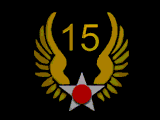Colonel Harold Jefferson, early in the war, served on the headquarters staff of the 15th Bomb Wing as armament and gunnery specialist and wing bombardier, passing on the combat training and
readiness of newly-formed heavy bombardment groups.
We heard earlier about how important and difficult that training was. He went on to fly combat in B-24s of the Fifteenth Air Force's 450th Bomb Group, serving as squadron armament
officer and staff bombardier of the 723rd Squadron. Colonel Jefferson flew as lead bombardier, was shot down on his thirty-seventh mission over Vienna, and wound up as a
prisoner of war in the infamous Stalagluft III north compound, the site, you may remember, of "the Great Escape" in Germany. With the
approach of the Red Army, over 10,000 prisoners were forced from
Stalagluft III through cold and blizzards to Spremberg on foot and to
Nuremberg and Stalag XIII-D by boxcar. Later, they were marched to
Stalag VII-A at Moosburg, where 110,000 Allied prisoners were finally
liberated by General Patton's 14th Armored Division.
Colonel Jefferson became a career U.S. Air Force intelligence officer,
right after the war helping to exploit German scientists and serving
as a senior targeting officer in Headquarters, SAC. He flew combat
missions in and served as Director of Targeting, Far East Air Forces
Bomber Command in the Korean War. He also served as Director
of Target Intelligence, Assistant Deputy Chief of Staff, Intelligence,
and Acting Deputy Chief of Staff, Intelligence, at Headquarters, Fifth
Air Force. Two tours in Headquarters, U.S. Air Force Intelligence, in
the Pentagon, a special assignment to organize and manage a new element
of the Defense Intelligence Agency, and a tour as Director of
Intelligence, Headquarters, Military Airlift Command, rounded out
his Air Force career. In the service, Colonel Jefferson earned a Master's
Degree and completed extensive Ph.D. studies in geopolitics and
international relations at Georgetown University. Active in the National
Organization of Ex-Prisoners of War, he's served two terms as
president of the Northern Virginia chapter and one on the board of the
Virginia state organization.
Copied from Page 10/11 of "Reflections and Remembrances".
The full story can be found on pages 26 through 34.
|



